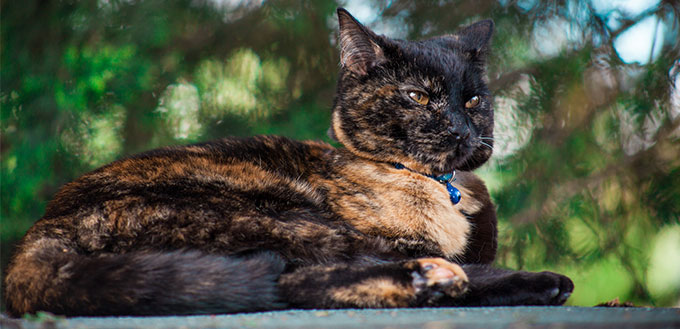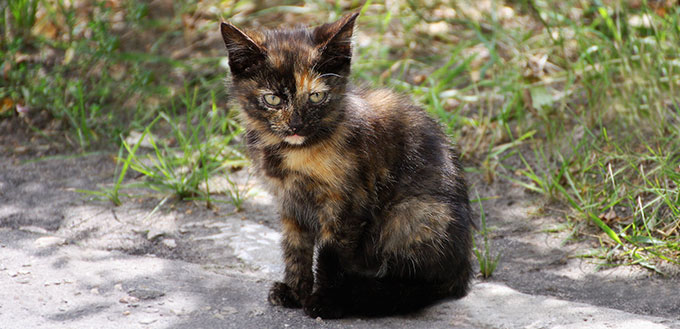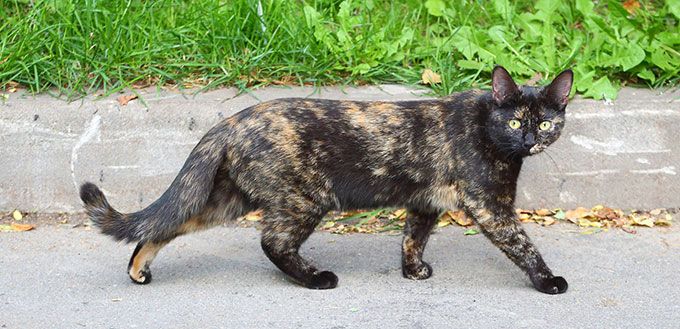Many pet owners love the rewards that come with having a kitty as part of the family. This is certainly true, as cats are very funny creatures. One cat you are not likely to go wrong with is the Tortoiseshell. Nicknamed the divas of the feline world, these beautiful creatures hide a multitude of amazing facts under their exceptional multi-color coats. Being called out for displaying stubborn, fierce, strong-willed, vocal, and sassy characters fade into nothing when compared to their fierce love and loyalty for family. If you are looking to adopt a cat with a big personality will find it with a Tortoiseshell. The cat will constantly keep you on your toes, thanks to its alleged “tortitude,” which sets it apart in the feline world.
History of the Tortoiseshell Cat
The name ‘Tortoiseshell’ is not given to a particular breed of cats; rather, it was derived from the kitty’s mishmash of diverse fur colors. Essentially, they were named after their coat coloring, which is close in resemblance to the shell of a tortoise. Tortoiseshells can occur among several breeds of cats, whether domesticated or feral. Inclusive on this list are the British Shorthair, Somali Cat, American Shorthair, American curl, Persian Cats, Manx cat, Oriental Shorthair, Cornish Rex, Burmese, and Devon Rex. We have also seen them among the Siamese, Norwegian Forest Cat, American bobtail, Maine Coon, Birman Cat, European Shorthair, Colorpoint Shorthair, Japanese Bobtail, and Turkish Van Cat.
Because Tortoiseshells come from different breeds, they don’t have a common history; thus, their traits differ from one kitty to the other. In addition, their life span, body weight, length, and height are also expected to differ. However, there is this tale of one Tortoiseshell called Marzipan that lived up to 21 years of age. Marzipan lived in Australia precisely at the Melbourne Astor Theatre where it arrived as a tortoiseshell kitten but died in 2013 following a protracted illness.
In addition to Marzipan, other tortoiseshell myths and folklore exist in several old cultures. According to a Southeast Asian myth from the Khmers, Tortoiseshells emanated from the blood of one juvenile deity who was born of some lotus flower. On their own part, fishermen of Japanese origin uphold that the presence of a tortoiseshell feline in a boat is a sure protection against ghosts and storms.
Another traceable myth where Tortoiseshells were mentioned goes back to the Celtic times when many people believe that the cat’s unique coloration heralds good fortune. Additionally, Tortoiseshells myths are also found in the US where they are sometimes referred to as ‘money cats’. Likewise, the Scottish and Irish view them as felines of fortune.
Quick Facts About the Tortoiseshell Cat
- As mentioned earlier, no particular breed is referred to as Tortoiseshell cat. They were given the name as a result of their distinguishing multi-colored coat. Traditionally, we expect to see a Tortoiseshell with orange, red, and black colors on display; however, there is usually a mix-in of brown. In addition, we also have the diluted Tortoiseshells with coloring that is less intense, thanks to genetics. Additionally, chocolate Tortoiseshells spurt coats of fur that are relatively much darker.
- Because they can occur within any breed, these exceptionally-colored kitties can be realized as long-haired or short-haired.
- Among the tribe of the Tortoiseshells, a mosaic coat style is recognized as the most widespread – this is often found in those Tortoiseshell cats that sport the traditional color combo randomly mixed together. Conversely, there is still another group called chimeras – this term is used to describe a Tortoiseshell sporting two distinctive sets of colors, one on each side of the body. This color demarcation can occur in the face alone, which is known as split-face pattern, and is usually orange on one side while the other half is covered in black. Furthermore, the dividing line is seen running down through the bridge of the cat’s nose. But in some cases, it will run throughout the cat’s entire body.
- The intricacies of the Tortoiseshell’s coat coloring still extend to include other categories classified as the patched and bridled. “Patched” brings all the Tortoiseshell cats with their colors occurring in large segments throughout the feline’s body under one umbrella. The color patches on the coat of a Tortoiseshell can vary from very fine speckled markings or patterns to larger areas or segments of color. On the other hand, bridled described another set of Tortoiseshells, with a coat color that has the appearance of being woven together.
- The fur coloration in Tortoiseshell kitties is dominated by a couple of colors, namely red and black. However, these two dominant colors can come in For one, the red color can come diluted as gold, yellow, cream, or even orange, while black might be diluted in variants of grey, chocolate, blue, tabby, and brown. It is all thanks to this variation that we can have a black and orange cat.
- The tribe of these distinctively colored cats are known to be dominated by females, just like the Tortoiseshell calico cats. Any tortoiseshell cat you spot will most likely turn out to be The reason behind this female dominance can be easily explained – the sex chromosome X, which represents the female is responsible for black and orange fur colors. With a couple of the X chromosomes, the female is privileged to be born with both black and orange fur. However, the story is different for the males as they have only a single X sex cell – thus, their coat can only carry either of the colors. This is why it is very difficult to have a male Tortoiseshell.
- Even with the established female dominance, the world has witnessed quite a few numbers of male Tortoiseshell cats that beat these genetic odds. However, the number of the males are very sparse and far apart and the possibility of a Tortoiseshell turning out as a male is about one out of every three thousand; usually as a result of some genetic mutation. Thanks to the imbalance of their sex cells (chromosomes), these occasional male tortoiseshell kitties remain sterile all through their lives and may suffer from other health problems.
- Torby is a term used to delineate those Tortoiseshell cats sporting the tabby markings among the patterns on their coats. More often than not, this category of cats is called Torbies or Tabby Tortoiseshell cats. The distinction between the Torbie and the Tortoiseshell lies in the fact that the coat of your typical Tortoiseshell would have black as their primary color. Sometimes, the difference between these two tribes can be quite confusing; this confusion is heightened by the fact that we still refer to Torbies as reverse Tortoiseshell
- Occasionally, we witness tabby patterns of brown and black; red color is also evident. This category of patched Tabby cats is known as Tortoiseshell-Tabby or T They are called ‘caliby’ when they display large white patches. Furthermore, we can still express the Tortoiseshell coloring in point pattern – this is called Tortoiseshell point.
- When a cat’s coat color has some white with a mixture of other colors such as cinnamon, chocolate, amber, red, tan, brown, and black, they are called Calico cats (in the US and Canada), Tortoiseshell-and-white (in the UK) or simply T These different color mixtures are often evident on the top side and on the backs, and it is their bellies that usually sport the white streak. Thus, any Tortoiseshell cat that displays a white belly is most likely to be a Calico. The ones deserving of the Tortoiseshell name are those particolored with comparatively little white markings or none at all. Typically, a cat’s color patches are believed to be more solid if it has more of the white color.
- The Tortoiseshell coat marking is evident in a plethora of cat breeds, including the designer breeds and pure breeds. We also see them occurring among wild cats in the great outdoors.
- A Tortoiseshell can live up to 14 years, but the case of Marzipan is a testament to the fact that they can survive longer than that. Their weight depends on the particular breed that the cat is coming from, but some have been known to weigh up to 10 pounds in body mass.
- Though very little scientific evidence exists to buttress this fact, Tortoiseshell adopters believe their feline friends to possess increased attitude, which is referred to as “tortitude” with respect to the tortoiseshell clan. According to many cat experts, a link exists between the Tortoiseshells coat pattern and the feline’s proclivity towards chasing, hissing, as well as biting people. The cat is believed to be endowed with a more distinctive personality relative to other cats.
Things You Should Know About the Tortoiseshell Cat
Health
Anticipated health issues for Tortoiseshell cats are also expected to follow their breed line. It is anticipated that each breed has the propensity to be born with any hereditary disease of its bloodline. For example, a Persian cat with the tortoise fur pattern may suffer from PKD known as polycystic kidney ailment, hypertrophic cardiomyopathy or HCM, PRA or dynamic retinal decay, and bladder stones.
In the same vein, you might observe signs of hip dysplasia, polycystic kidneys, and spinal muscular atrophy in a Main Coon with the Tortoiseshell coat pattern. However, one major issue that ails all male Tortoiseshell cats is sterility, which has no cure as they were all born that way.
Feeding
Feeding for a typical Tortoiseshell is no different from what you do with other cats. Their diet should be high in the all-important animal protein required for healthy growth, including essential vitamins and minerals. However, there are several things to take into consideration before deciding on the quantity of kibble to feed a cat. If your feline friend happens to be an outdoor cat, you have to factor in that it may be killing and eating whole prey without your knowledge; thus, the quantity of food for an indoor-only cat can never be the same with an outdoor cat.
Other factors to consider are body weight, age, state of health, and activity level. All these will aid a pet parent in mitigating against overweight, which in itself is a health problem. If your cat is a couch potato, then you must reduce its ration to avoid resultant ailments that may come as a consequence of obesity, you can do that with the help of an automatic feline feeder.
On the frequency of feeding, you might not always be available as a pet parent and would prefer the free feeding method where the food is always available for your kitty to eat at will. Likewise, it’s normal if you opt to regulate your kitty’s feeding with two meals a day; one in the morning and another in the evening.
Care
Tortoiseshells need care just like every other feline. Bathroom hygiene is very important as cats are very particular about that. Their litter boxes need constant cleaning with the litter changed from time to time. Always keep your feline companion indoors to avoid incidents of theft, accidents from moving vehicles, or threat from bigger animals. Besides, cats that are allowed to move outside are at the risk of contracting diseases and viruses. Furthermore, provide your cat with a scratcher or scratching post to reduce damage to your household furniture and equipment. Likewise, water should be kept handy regularly, and you must train your pet to always do its business within the litter box.
Grooming
A tortoiseshell cat must be groomed according to the dictates of its breed. If the cat belongs to long-haired breeds like the Maine Coon, then brushing must be done more regularly than you would with a short-haired Tortoiseshell. By doing so, you will prevent all the matting and hair loss that comes with the long hair trail. However, brushing should be increased during their shedding period as some felines are not good at self-grooming. The essence of brushing is to aid in evenly distributing their skin oil, disentangle mats and keep the coat in tip-top condition.
You should also expose your fur buddy to a thorough bathing session from time to time and be sure to use a mild shampoo made exclusively formulated for cats. It is not necessary to wash your cat’s face as this may portend some serious issues – apart from leaving you with an unhappy kitty, you might end up causing more health problems. Thus, washing should be restricted to the body alone.
What’s more, your cat’s teeth, eyes, and ears need to be taken into consideration. Prevent the occurrence of periodontal disease by brushing your cat’s teeth on a regular basis – once a day is good, but pet parents who cannot cope with daily brushing can try doing it once weekly. This way, you reduce the amount of tartar that has accumulated. Additionally, a sufficient amount of chew toys, can further assist with dental care.
Furthermore, regular ear checks are vital to prevent the build up of wax or the risk of ear infection. You cat’s ears ought to be cleaned when the need arises. A moist clean cloth will suffice for cleaning the ears, but it is best to use cotton balls moistened with water. Likewise, their eyes need to be equally cleaned from time to time, and the nails clipped when necessary.
Temperament
Since no two Tortoiseshells are expected to be the same, their character traits and temperament are also expected to differ. The Tortoiseshell cat’s personality, otherwise known as tortitude, has been extensively discussed on the internet, identifying a wide range of individual characteristics.
Some Tortoiseshells are very vocal, feisty, and headstrong. They might be calm one moment, and the next second, they are already reaching out for your legs to use as a scratching post. While we have seen some that are completely “anti-Tortoiseshell” with traits of shyness, calmness, and gentleness, there are still many that are highly sensitive to their environment and tend to view anything in their vicinity as a threat.
We have also seen many Tortoiseshells that are just excited about life – they just love everything that comes their way, including people. As for their alleged tortitude, not every Tortoiseshell feline will display the character traits attributed to these beautifully colored cats, but it is widely believed that tortitude is a reality.
In a nutshell, Tortoiseshells are highly energetic; there is even this widely held belief that a Tortoiseshell kitten comes much tougher than the offspring of other cats. They are known to be opinionated and a bit aloof, and detached, going about their day to day business like they are above everything, including people.
The cat’s independent nature might be the reason for its unpredictability. These divas of the feline world must be provided with a lot of distractions, and there should be sufficient playtime and training sessions to aid them in exerting their pent up energy. In conclusion, we must reiterate the fact that these predictions may not always come true with every single Tortoiseshell because each has its individuality.











I adopted a tortoiseshell and a tuxedo. I put 1/2 a cup of kibbles for them am and PM. In the evening they each get 1/6 of a small tin of meat. I alternate between meat based and fish based. The tux is sleek and trim and miss tortie is a football!! She’s just a bit short of 2yrs( not positive) What should I look for in the line of negative effects of her size? Thank you in advance for any info.